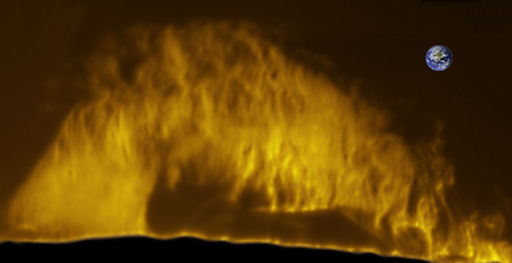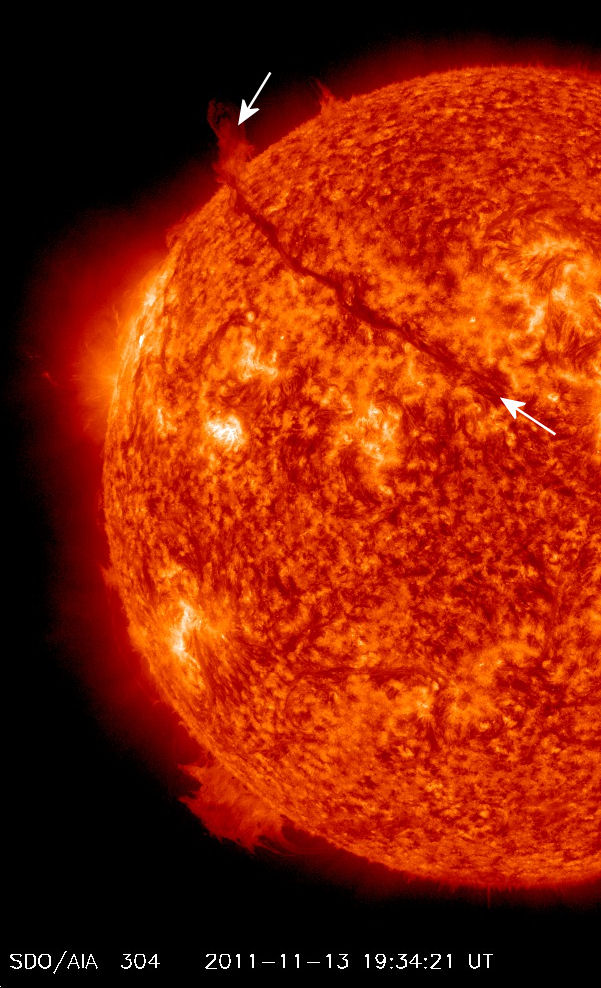Een zonnevlam (flare) is een explosie op het oppervlak van de zon, die ontstaat door het plotseling vrijkomen van de energie die wordt vastgehouden in de magnetische velden. Er ontstaat straling over het hele gebied van het elektromagnetische spectrum.
Zonnevlammen worden ingedeeld in drie hoofd-klassen:
1. X-klasse zonnevlammen. Dit zijn uitbarstingen die op de aarde voor het uitvallen van radioverbindingen en van elektriciteitscentrales kunnen zorgen.
2. M-klasse zonnevlammen. Dit zijn matige uitbarstingen, die rond de polen korte perioden van uitval van de radioverbindingen kunnen veroorzaken.
3. C-klasse zonnevlammen. Kleine uitbarstingen die nauwelijks invloed hebben op de aarde.
Meer objectief worden de zonnevlammen ingedeeld aan de hand van de uitgestraalde energie (Watt per m≤ in golflengten tussen 1 en 8 ŚngstrŲm). X-klasse zonnevlammen geven een energie af van meer dan 10-4 Watt/m2, M-klassen tussen de 10-4en 10-5 en C-klassen tussen 10-5en 10-6 Watt/m2. Iedere klasse loopt van 1 tot 9, dus bijv. C1 tot C9.
Bekende X-klasse zonnevlammen waren die van maart 1989, die grote schade aan elektriciteitscentrales in Canada veroorzaakte en de uitbarsting op 4 november 2003, die zo groot was dat hij niet te meten was. Geschat wordt dat deze uitbarsting geclassificeerd moet worden als X28. De richting van deze laatste uitbarsting was niet naar de aarde toe, zodat het effect op aarde niet zo groot was.
Materie uitgestoten bij zonnevlammen komt uiteindelijk terecht in de zonnewind.


Vorige topic
Magneetstormen & Zonnevlammen
Linkjes
Spaceweather.com
Zonnevlammen WIKI (Engels)
Actueel Zonnevlam gevaar
Solarevents - Last updates
[ Bericht 0% gewijzigd door Frutsel op 01-08-2011 09:17:01 ]
quote:Sterrenwacht waarschuwt voor "extreem ruimteweer"
Bij de Koninklijke Sterrenwacht (KSB) zijn afgelopen nacht de automatische alarmsystemen in werking getreden: op de Zon is een extreme zonnevlam waargenomen. Dat meldt de KSB, die waarschuwt voor een mogelijke impact voor onze planeet. De vorige zonnevlam van die grootte dateert van december 2006. Sommigen opperden in 2009 zelfs dat de Zon zogenaamd "dood" zou zijn. Maar niets is minder waar, aldus de KSB. Volgens de gespecialiseerde website spaceweater.com deed zich de eerste zogenaamde "x-flare" voor van de nieuwe zonnecyclus (die 11 jaar duurt), de 24ste cyclus. De piek was om 02.56 uur Belgische tijd.
De KSB waarschuwt op basis van satellietgegevens, onder andere van de Belgische Proba-2 satelliet, dat een plasmawolk zich richting Aarde voortbeweegt met een vermoedelijke snelheid van 1.000 km/s. Die wolk zal de Aarde donderdag treffen. Een satelliet die zich vlak voor de Aarde in het zicht van de Zon bevindt heeft ook reeds een stroom van energetische deeltjes waargenomen. Voorlopig is het stormniveau niet bereikt, voegt de KSB eraan toe.
Noorderlicht
Het ruimteweerteam moet nu in de eerste plaats de magnetische structuur van de wolk proberen te achterhalen. Die bepaalt hoe het magnetisch schild van de Aarde op de impact zal reageren. Als een aantal voorwaarden zijn voldaan, kunnen we misschien donderdag het noorderlicht waarnemen, zegt de Sterrenwacht. Extreem ruimteweer kan satellieten doen uitvallen en kan gevolgen hebben voor de stroomvoorziening op Aarde.
Grootste vlam sinds tijden, een X2.2 , heading for earthquote:Monsterflare heading for earth
The sun unleashed its strongest solar flare in four years last night (Feb. 14), hurling a massive wave of charged particles from electrified gas into space and toward Earth.
The solar storm sent a flash of radiation that hit Earth in a matter of minutes. Now a huge cloud of charged particles is headed our way. These coronal mass ejections, as they are called, typically take around 24 hours or more to arrive. They can spark spectacular displays of the aurora borealis, or Northern Lights, at high latitudes and sometimes even into the northern United States.
The mega flare, which registered as a Class X2.2 flare on the scale of solar flares, was the first class X flare to occur in the new solar cycle of activity, which began last year. The sun is now ramping up toward a solar maximum around 2013.
"It has been the largest flare since Dec 6, 2006, so a long time coming," said Phil Chamberlin, deputy project scientistfor NASA's Solar Dynamics Observatory, which observed the flare. "There were some clues that led us to believe the likelihood of moderate to large flares (M class or above) could occur, but we were all surprised when it actually happened to be a large X-class."
Class X flares are the strongest types of solar flares that can erupt from the sun. There are also two weaker categories: Class M flares, which are medium strength but still powerful, and Class C flares, which are the weakest storms from the sun.
Last night's X2.2 flare is the most powerful solar eruption of the sun's current weather cycle, called Solar Cycle 24. According to the website Spaceweather.com, which monitors space weather and skywatching events, the flare was the strongest of the last four years.
"It just means that Solar Cycle 24 is ramping up!" Chamberlin told SPACE.com. "This is the first of probably many more X-class flare to occur over the next 2 to 4 years as we reach the peak and then descend back down from solar cycle 24 maximum."
The Monday flare came on the heels of another, only slightly less powerful, class M6.6 flare on Sunday, Feb. 13. Both events erupted from the same area on the sun, called active region 1158
"AR 1158 is in the southern hemisphere, which has been lagging the north in activity but now leads in big flares!" NASA scientists wrote on the Solar Dynamics Observatory website.
Yesterday's Class X flare erupted at 8:50 p.m. EST on Feb.14 (0150 GMT Feb. 15).
Such a flare can bathe the Earth in high doses of ultraviolet radiation and X-rays hurl a huge burst of solar wind in our direction. When this burst arrives at Earth, the electrons and protons from the solar wind come into contact with our planet's magnetic field, and stream toward the magnetic poles.
The disturbance can create a geomagnetic storm in Earth's magnetic field.
"Geomagnetic storms are possible when the CME arrives 36 to 48 hours hence," Spaceweather.com reported.
Morgen dan een aardig kansje om het te zien? Voorlopig laat Hirlam voor het grootste gedeelte van het land helder verlopen.quote:Als de plasmastorm zich met ong. 1000 km/p sec voortbeweegt en de afstand tussen aarde en zon 150 miljoen kilometer = de verwachte aankomsttijd dus 20.56u Nederlandse tijd op 16 februari, dus. Ben benieuwd of deze berekening gaat kloppen...

Wat kunnen we verwachten?
Niks waarschijnlijkquote:Op dinsdag 15 februari 2011 23:16 schreef Yi-Long het volgende:
Goed, wat nu!? Gaan we dood? Gaan we zwemmen? Moet ik al mijn HDD's beschermen!? Loopt mijn 360 gevaar? Wordt het morgen lekker zonnig!?
Wat kunnen we verwachten?
Langzaam internet en sneeuw op tv.quote:
Als je een beetje pech hebt hebben we helemaal geen stroomquote:Op dinsdag 15 februari 2011 23:20 schreef Papierversnipperaar het volgende:
[..]
Langzaam internet en sneeuw op tv.
Poollicht...................................................................................................... hopelijkquote:Op dinsdag 15 februari 2011 23:16 schreef Yi-Long het volgende:
Goed, wat nu!? Gaan we dood? Gaan we zwemmen? Moet ik al mijn HDD's beschermen!? Loopt mijn 360 gevaar? Wordt het morgen lekker zonnig!?
Wat kunnen we verwachten?
Dit is nog teleurstellender dan het nieuws van 2 weken geleden dat Yosemite op springen stond...quote:
Och... daar valt mee te leven...quote:Op dinsdag 15 februari 2011 23:20 schreef Papierversnipperaar het volgende:
[..]
Langzaam internet en sneeuw op tv.
Een andere boosdoener is de maan. die is prominent aanwezigquote:Op dinsdag 15 februari 2011 23:07 schreef meteo-online het volgende:
[..]
Morgen dan een aardig kansje om het te zien? Voorlopig laat Hirlam voor het grootste gedeelte van het land helder verlopen.
[ afbeelding ]

[ Bericht 8% gewijzigd door -CRASH- op 16-02-2011 00:17:15 ]
Ben benieuwd hoe laat de plasmastorm uiteindelijk aankomt. En of er wat van te zien valt, gezien de maan, die gaat storen en de evt. bewolking.quote:Laatste tweet NoorderlichtNL
15 Feb 2011 22:43:10
RT @poollicht: Voorspellers verwachten impact schokgolf donderdagmorgen rond 4 uur, onzekerheid van paar uur. Kans op #poollicht in BE/N ...
quote:Op dinsdag 15 februari 2011 23:16 schreef Yi-Long het volgende:
Goed, wat nu!? Gaan we dood? Gaan we zwemmen? Moet ik al mijn HDD's beschermen!? Loopt mijn 360 gevaar? Wordt het morgen lekker zonnig!?
Wat kunnen we verwachten?
Er gebeurt gewoon niks. Onze Maker heeft er grotere plannen met ons.quote:Op woensdag 16 februari 2011 03:02 schreef Seam het volgende:
Onzekerheid van een paar uur, dus waarschijnlijk zal ik het wel missen, aangezien ik niet tot zes uur in de ochtend wakker wil blijven.
Ik weet niet waar jij woont, maar het is hier in Alkmaar nu heerlijk weerquote:
Stiekem hoop ik van wel. Ik weet dat dit voor vele bedrijven en mensen echt een groot probleem is, maar zoiets maak je niet vaak mee ten gevolge van een zonnevlam.quote:Op woensdag 16 februari 2011 11:54 schreef summer2bird het volgende:
Komen er morgen ook stroomstoringen?
En een beetje noorderlicht zou al helemaal vet zijn.
RSOE EDIS
Kom dan vanavond op IRC #poollicht voor mededeingen en vragen.
Er zullen ook mensen "live in het veld" aanwezig zijn voor updates
Daar kom je lekker laat mee... had je al veel eerder moeten doen.quote:Op woensdag 16 februari 2011 15:56 schreef rubje het volgende:
ff een vraagje tussendoor: Moet ik alvast voor de komende maanden proviand ed gaan inslaan en een bunker bouwen?
In Friesland is het bewolkt.quote:Op dinsdag 15 februari 2011 23:07 schreef meteo-online het volgende:
[..]
Morgen dan een aardig kansje om het te zien? Voorlopig laat Hirlam voor het grootste gedeelte van het land helder verlopen.
[ afbeelding ]
Als het goed is niet lang meer:quote:


En van hoe laat tot hoe laat?
710km/s?quote:Op woensdag 16 februari 2011 18:39 schreef horned_reaper het volgende:
De vertreksnelheid van de zonnevlam van gisternacht is met 710 km/s niet zo heel erg groot en de protonenstorm blijft tot nu binnen de perken dus het zal waarschijnlijk wel meevallen de problemen die in de media benadrukt worden.
Dat is van Holwerd naar …vreux, Frankrijk in 1 seconden
Vraag ik mij ook af.quote:Op woensdag 16 februari 2011 17:46 schreef Infection het volgende:
Als het noorderlicht te zien is, hoe lang blijft zoiets zichtbaar vraag ik me af?
En van hoe laat tot hoe laat?
Precies, een slaapverwekkende snelheid voor deeltjes die 8 lichtminuten moeten overbruggen.quote:Op woensdag 16 februari 2011 19:14 schreef SpeedyGJ het volgende:
[..]
710km/s?
Dat is van Holwerd naar …vreux, Frankrijk in 1 seconden
Vanaf middernacht. http://www.deredactie.be/cm/vrtnieuws/binnenland/110216_noorderlichtquote:Op woensdag 16 februari 2011 17:46 schreef Infection het volgende:
Als het noorderlicht te zien is, hoe lang blijft zoiets zichtbaar vraag ik me af?
En van hoe laat tot hoe laat?
Verwachte schokgolf impact...Donderdagmorgen rond 4 uurquote:Op woensdag 16 februari 2011 20:07 schreef RiKe het volgende:
Dus als ik het goed begrijp, vannacht vanaf middernacht, en dan kijken in noordelijke richting?
http://twitter.com/search?q=%23poollicht
Ja gloeiende gloeiende...dan slaap ik!quote:Op woensdag 16 februari 2011 20:18 schreef -CRASH- het volgende:
[..]
Verwachte schokgolf impact...Donderdagmorgen rond 4 uur
http://twitter.com/search?q=%23poollicht
Kan dat poollicht niet even in de file komen ofzo?
Ja, dat wil je hebben. Duizenden mobilisten die 5 km per uur rijden en dan denken dat het veilig is om 30 seconden naar de lucht te staren...quote:Op woensdag 16 februari 2011 20:21 schreef RiKe het volgende:
[..]
Ja gloeiende gloeiende...dan slaap ik!
Kan dat poollicht niet even in de file komen ofzo?
...dan sta je idd nog wel even in de file...
Wekker zetten en nu naar bed.quote:
Uurtje of 9 morgenavond kan makkelijk toch?quote:Op woensdag 16 februari 2011 20:35 schreef Yi-Long het volgende:
[..]
Ja, dat wil je hebben. Duizenden mobilisten die 5 km per uur rijden en dan denken dat het veilig is om 30 seconden naar de lucht te staren...
...dan sta je idd nog wel even in de file...
[ Bericht 0% gewijzigd door Odysseuzzz op 16-02-2011 21:18:54 ]
Stilte voor een storm die wel/niet gaat komen...?
* ben nog steeds benieuwd, maar ga er mn wekker niet voor zetten*
Wie wel?
Toevallig ook UPC!?quote:Op woensdag 16 februari 2011 22:12 schreef TLC het volgende:
Heeft het ook invloed op het Internet ? bij mij ligt dat er steeds uit vanavond
UPC heeft namelijk geen zonnevlammen nodig om te kutten met de internetverbinding...
Handig zo'n stage bij Astron
Zijn die Łberhaupt te zien dan?quote:Op donderdag 17 februari 2011 10:25 schreef DutchErrorist het volgende:
Net zonnevlammen gespot met een telescoop
Handig zo'n stage bij Astron
Ja echt heel duidelijkquote:Op donderdag 17 februari 2011 10:38 schreef Infection het volgende:
[..]
Zijn die Łberhaupt te zien dan?
Het werd zo mistig dat zelfs de bijna volle maan nauwelijks meer te zien was..jammer..
Tevens Beilen zonder stroom, en ABN en IGN pin werkten niet/matig. Geen idee alleen of het hier mee verband houd, ik gok van niet.
Ook echt geluid steeds hoger bij hogere frequenties.
Wat is het mooi......mijn leven is veranderd!
Crap het is een flikkerende TL balk
OH NOES WE GAAN DOOD!quote:The strongest solar flare in four years disrupted radio communications in southern China, according to the China Meteorological Administration. The powerful solar eruption triggered a huge geomagnetic storm has disturbed radio communications and could disrupt electrical power grids, radio and satellite communication in the next days, NASA said.
A strong wave of charged plasma particles emanating from the Jupiter-sized sun spot, the most powerful seen in four years, has already disrupted radio communication in southern China.
The Class X flash -- the largest such category -- erupted at 0156 GMT Tuesday, according to the US space agency.
http://www.scientias.nl/p(...)et-in-het-eten/25523
Ik heb misschien een beetje domme vraag, daar ik nog relatief een nieuweling ben met telescopen, maar hoe is het Łberhaupt mogelijk om de zon te bekijken? Je kan dat niet eens doen met je blote oog, zou je je ogen niet permanent verblinden als je dit doet door een gerichte lens?quote:Op donderdag 17 februari 2011 10:56 schreef DutchErrorist het volgende:
[..]
Ja echt heel duidelijk(Niet die richting de aarde, tenzij je aan de filter draait en het veel vaker hebt gedaan) Maar die om de zon heen zag je heel duidelijk... linksboven en rechtsboven.. Zag ook die zwarte plekken
Ja ware het niet dat er een speciale filter voor zat die alleen een bepaald rood licht door liet (anders kan je de vlammen ook niet zien).quote:Op donderdag 17 februari 2011 18:36 schreef vergezocht het volgende:
[..]
Ik heb misschien een beetje domme vraag, daar ik nog relatief een nieuweling ben met telescopen, maar hoe is het Łberhaupt mogelijk om de zon te bekijken? Je kan dat niet eens doen met je blote oog, zou je je ogen niet permanent verblinden als je dit doet door een gerichte lens?
Zonder lens ben je gelijk blind.
Die filter is ingebouwd? Maar hopen dat ie nooit kapot raaktquote:Op donderdag 17 februari 2011 18:37 schreef DutchErrorist het volgende:
[..]
Ja ware het niet dat er een speciale filter voor zat die alleen een bepaald rood licht door liet (anders kan je de vlammen ook niet zien).
Zonder lens ben je gelijk blind.
Een telescoop is net een fototoestel, je kan zelf lenzen en filters plaatsen.quote:Op donderdag 17 februari 2011 18:41 schreef vergezocht het volgende:
[..]
Die filter is ingebouwd? Maar hopen dat ie nooit kapot raakt
dus je hebt een gewone zonnefilter erinquote:Op donderdag 17 februari 2011 18:37 schreef DutchErrorist het volgende:
[..]
Ja ware het niet dat er een speciale filter voor zat die alleen een bepaald rood licht door liet (anders kan je de vlammen ook niet zien).
Zonder lens ben je gelijk blind.
die je op onderkant van je lens schroeft ?
Je kan ook vanaf de opening filteren. Dan komt er geen direct zonlicht in de telescoop en blijft ie koeler.quote:Op donderdag 17 februari 2011 19:15 schreef -CRASH- het volgende:
[..]
dus je hebt een gewone zonnefilter erin
die je op onderkant van je lens schroeft ?
Men kope een zak chips.
Men ete de chips op.
Men scheure de zak open.
Men plaatse de zak over de telescoop met elastiek.
quote:Op donderdag 17 februari 2011 19:21 schreef Papierversnipperaar het volgende:
[..]
Je kan ook vanaf de opening filteren. Dan komt er geen direct zonlicht in de telescoop en blijft ie koeler.
Men kope een zak chips.
Men ete de chips op.
Men scheure de zak open.
Men plaatse de zak over de telescoop met elastiek.
Koop dan gelijk mylar folie. chipszak zitteb miniscule beschadigingen op en is vettig.
Dat lijkt met niet nee.quote:Op donderdag 17 februari 2011 18:41 schreef vergezocht het volgende:
[..]
Die filter is ingebouwd? Maar hopen dat ie nooit kapot raakt
Zie je dan wel zonnevlammetjes?quote:Op donderdag 17 februari 2011 19:32 schreef -CRASH- het volgende:
[..]

Koop dan gelijk mylar folie. chipszak zitteb miniscule beschadigingen op en is vettig.
quote:Plasmawolk bereikt aarde
De plasmawolk die maandag de zon heeft verlaten, heeft vrijdagmorgen de aarde bereikt. De 'coronal mass ejection' botste omstreeks 02.00 uur Belgische tijd met het magnetisch veld van de aarde. De impact was niet zo hevig als enkele dagen eerder werd verwacht.
Donderdag had de Koninklijke Belgische Sterrenwacht al laten weten dat de plasmawolk hoogstwaarschijnlijk was vertraagd door de zonnewind en door twee voorafgaande minder snelle plasmawolken.
De wolk heeft hierdoor een deel van zijn energie verloren, wat verklaart dat de impact minder energetisch was. De voorspelling luidde dat er in BelgiŽ geen poollicht te zien zou zijn.
Zonnemassa
Een plasmawolk is een grote hoeveelheid zonnemassa die wordt weggekatapulteerd. Zo'n wolk bereikt meestal na twee tot vijf dagen onze planeet als ze onze richting uitvliegt. Een plasmawolk kan een magnetische storm veroorzaken.
Radiocommunicatie wordt bemoeilijkt of kan wegvallen, navigatiesystemen ondervinden nadeel, elektrische stromen kunnen geÔnduceerd worden in elektriciteits- en pijpleidingen. Bij magnetische stormen is de breedtegraad belangrijk. Of het dag of nacht is, maakt niet uit.
Het magnetisch veld van de aarde beschermt ons tegen de impact van plasmawolken.
Neequote:Op donderdag 17 februari 2011 21:29 schreef DutchErrorist het volgende:
[..]
Dat lijkt met niet nee.
[..]
Zie je dan wel zonnevlammetjes?
Daar heb je volgens mij een H-Alfa filter voor nodig.
http://www.youtube.com/results?search_query=sun+flares&aq=f
quote:Scientists warn for solar 'Katrina'
The sun is waking up from a long quiet spell. Last week it sent out the strongest flare for four years – and scientists are warning that earth should prepare for an intense electromagnetic storm that, in the worst case, could be a “global Katrina” costing the world economy $2,000bn.
Senior officials responsible for policy on solar storms – also known as space weather – in the US, UK and Sweden urged more preparedness at the annual meeting of the American Association for the Advancement of Science in Washington.
“We have to take the issue of space weather seriously,” said Sir John Beddington, UK chief scientist. “The sun is coming out of a quiet period, and our vulnerability has increased since the last solar maximum [around 2000].”
“Predict and prepare should be the watchwords,” agreed Jane Lubchenco, head of the US National Oceanic and Atmospheric Administration. “So much more of our technology is vulnerable than it was 10 years ago.”
A solar storm starts with an eruption of super-hot gas travelling out from the sun at speeds of up to 5m miles an hour. Electrically charged particles hit earth’s atmosphere 20 to 30 hours later, causing electromagnetic havoc.
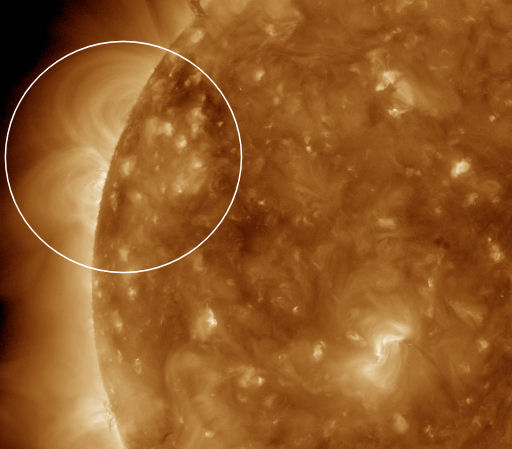
quote:APPROACHING ACTIVE REGION: A significant active region is about to emerge over the sun's northeastern limb. The underlying sunspots are not yet visible from Earth, but the region's towering magnetic canopy is already in view. NASA's Solar Dynamics Observatory (SDO) took this picture during the early hours of Feb. 23rd:
A better view is had by NASA's STEREO-B probe, stationed over the sun's eastern limb where it can see the region from top down. Recent movies beamed back by STEREO-B show flashes of extreme UV radiation and hints of magnetic instability. This could herald a period of renewed solar activity when the region turns toward Earth in the days ahead. Or the action could peter out beforehand. Stay tuned for updates.
Bron: Spaceweather.com
Niiiiiiiiiiicequote:

quote:The quiet didn't last long. Earth-orbiting satellites detected an M3-class solar flare at 0735 UT on Feb. 24th. The source was an active region located just behind the sun's eastern limb. The eruption produced strong radio emissions, a coronal mass ejection (not Earth directed), and this spectacular picture taken by NASA's Solar Dynamics Observatory:
The active region responsible for this blast will emerge over the eastern limb during the next 24-48 hours, setting the stage for possible geoeffective solar activity. Stay tuned for updates.
Lekker klotsen met de zon. ^^quote:
Dat komt omdat de afgelopen rustige periode zo rustig was dat mensen de zon voor "dood" verklaarden, en nu word een heftige actieve periode verwacht.quote:Op maandag 28 februari 2011 19:36 schreef pinine het volgende:
't zijn gewoon natuurlijke processen die regelmatig voorkomen alleen nu lijkt de aandacht wel erg sterk gericht op elke nieuwe zonnevlam
Dus je zegt eigenlijk dat het meevalt, want vergeleken met de dood is de activiteit toch middelmatig.quote:Op maandag 28 februari 2011 19:54 schreef Papierversnipperaar het volgende:
[..]
Dat komt omdat de afgelopen rustige periode zo rustig was dat mensen de zon voor "dood" verklaarden, en nu word een heftige actieve periode verwacht.
KP5 storm
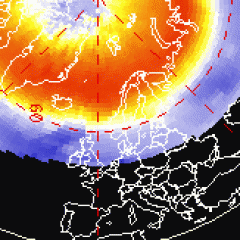
donkere hemel en vrije horizon.
Groen poollicht tot ca. 5į boven noordelijke horizon.
Daarboven is rood/violet mogelijk.
www.spaceweather.nl
Post ze maarquote:Op dinsdag 8 maart 2011 13:38 schreef DutchErrorist het volgende:
Net een paar foto's gemaakt van de zon, je kan zelfs een zonnevlam zien

Verotte JPEG maar goed je snapt het idee wel, zal vanavond eens naar de .RAW bestanden kijken
Nicequote:Op dinsdag 8 maart 2011 14:18 schreef DutchErrorist het volgende:
[ afbeelding ]
Verotte JPEG maar goed je snapt het idee wel, zal vanavond eens naar de .RAW bestanden kijken
Oh volgens mij is de foto trouwens geflipt en hoort de vlam linksonder te zitten maar goed. Een collega had nog een mooiere door een paar te stackenquote:
Of is het weer een storm in een glaasje water waar we niets van zullen zien?
Bron: Spaceweatherquote:Another X-flare heading for earth?
X-FLARE: March 9th ended with a powerful solar flare. Earth-orbiting satellites detected an X1.5-class explosion from behemoth sunspot 1166 around 2323 UT. A movie from NASA's Solar Dynamics Observatory shows a bright flash of UV radiation plus some material being hurled away from the blast site:
A first look at coronagraph images from NASA's STEREO-B spacecraft suggests that the explosion did propel a coronal mass ejection (CME) toward Earth. This conclusion is preliminary, however, so check back later for updates.
After four years without any X-flares, the sun has produced two of the powerful blasts in less than one month: Feb. 15th and March 9th. This continues the recent trend of increasing solar activity, and shows that Solar Cycle 24 is heating up. NOAA forecasters estimate a 5% chance of more X-flares during the next 24 hours
Poollicht misschien te zien bij heldere transparante donkere hemel en vrije horizon. Groen poollicht tot ca. 5į boven noordelijke horizon. Daarboven is rood/violet mogelijk
http://www.poollicht.info/
Ik ben net buiten geweest, het is helder weer, zit op 63 graden noord, maar er is niks te zien momenteel...quote:Op donderdag 10 maart 2011 21:46 schreef -CRASH- het volgende:
Op dit moment (21:44) >>>
Poollicht misschien te zien bij heldere transparante donkere hemel en vrije horizon. Groen poollicht tot ca. 5į boven noordelijke horizon. Daarboven is rood/violet mogelijk
http://www.poollicht.info/
Geen noorderlicht in Nederland
Poollicht misschien te zien bij heldere donkere hemel! Groen poollicht tot ca. 10į boven noordelijke horizon. Daarboven is rood/violet mogelijk.
www.spaceweather.nlquote:A big sunspot is emerging over the sun's southeastern limb, and it is crackling with activity. NASA's Solar Dynamics Observatory recorded a surge of extreme ultraviolet radiation from the sunspot's magnetic canopy on March 21st:
This appears to be the return of old sunspot 1165, last seen in early March when it formed on the sun's southwestern limb. Since then it has been transiting the far side of the sun, apparently growing in size and restlessness. The potential for trouble will become more clear in the hours ahead as the active region emerges in full. Stay tuned.
De zon was weer even rustig. Maar wellicht dat deze onrustige zonnevlek voor beroering gaat zorgen. Dat is altijd maar weer afwachten.
SPOILERNEE, niet bedoeld om paniek te zaaien
.comquote:
Yo!quote:
www.spaceweather.com
Ik vergeef je....quote:Op dinsdag 22 maart 2011 00:09 schreef zenkelly het volgende:
[..]
Yo!Het was het tijdstip van schrijven en je hebt helemaaaaal gelijk natuurlijk!
www.spaceweather.com
Wordt weer eens een keer tijd voor een groot schouwspel aan de Nederlandse hemel.
Ik was m'n CD collectie aan het uitdunnen... En kwam deze nog tegen
Begin van de lichtshow (?)





Teringquote:Op zondag 3 april 2011 22:53 schreef -CRASH- het volgende:


It''s huge..... Maar "gelukkig?!?!" aan de achterkant van de zon
[ afbeelding ]
Komende uren
Behoorlijke kans op noorderlicht laag in het noorden.
http://www.poollicht.info/
Wat moet ik verstaan onder LAAG in het noorden????
Net boven de horizon.quote:Op woensdag 6 april 2011 18:35 schreef -CRASH- het volgende:
Wat moet ik verstaan onder LAAG in het noorden????
Normaal zetten ze er gewoon "in het noorden" neer.quote:
Poollicht misschien te zien bij heldere transparante donkere hemel en vrije horizon. Groen poollicht tot ca. 5į boven noordelijke horizon. Daarboven is rood/violet mogelijk.
http://www.poollicht.info/
quote:Solar activity heats up
April 14, 2011: If you've ever stood in front of a hot stove, watching a pot of water and waiting impatiently for it to boil, you know what it feels like to be a solar physicist.
Back in 2008, the solar cycle plunged into the deepest minimum in nearly a century. Sunspots all but vanished, solar flares subsided, and the sun was eerily quiet.
"Ever since, we've been waiting for solar activity to pick up," says Richard Fisher, head of the Heliophysics Division at NASA Headquarters in Washington DC. "It's been three long years."
Quiet spells on the sun are nothing new. They come along every 11 years or so—it's a natural part of the solar cycle. This particular solar minimum, however, was lasting longer than usual, prompting some researchers to wonder if it would ever end.
News flash: The pot is starting to boil. "Finally," says Fisher, "we are beginning to see some action."
As 2011 unfolds, sunspots have returned and they are crackling with activity. On February 15th and again on March 9th, Earth orbiting satellites detected a pair of "X-class" solar flares--the most powerful kind of x-ray flare. The last such eruption occurred back in December 2006.
Another eruption on March 7th hurled a billion-ton cloud of plasma away from the sun at five million mph (2200 km/s). The rapidly expanding cloud wasn't aimed directly at Earth, but it did deliver a glancing blow to our planet's magnetic field. The off-center impact on March 10th was enough to send Northern Lights spilling over the Canadian border into US states such as Wisconsin, Minnesota, and Michigan.
Dus je kunt zonnevlammen zien.
[ Bericht 21% gewijzigd door -CRASH- op 19-04-2011 17:55:33 ]

http://spaceweather.com/
het is al de 2de dag nacht dat er gekleurde poollichten te zien zijn.
Ik denk dat ik maar de komende jaren naar het noordedn emigreer
2 mei: redelijke kans op noorderlicht
http://www.poollicht.info/
There's no known way that the wispy, vaporous remains of a relatively lightweight comet could cause a billion-ton cloud of hot plasma to fly away from the sun at 400 km/s (the observed speed of the CME). Moreover, NASA's Solar Dynamics Observatory photographed the eruption that did propel the CME into space. There's no comet in the field of viewquote:
www.spaceweather.com
Zonnestormen vormen een steeds groter risico voor belangrijke infrastructuur, zoals communicatiesatellieten, navigatiesystemen en elektrische zendapparatuur. Dat heeft Kathryn Sullivan van de Amerikaanse Nationale Oceanische en Atmosferische Dienst (NOAA) dinsdag gezegd.
De verwachting is dat de zonnestormen in 2013 hun hoogtepunt bereiken. Volgens NOAA moeten landen zich opmaken voor 'potentieel rampzalige effecten'. Volgens Sullivan, een voormalige NASA-astronaute, is het niet 'de vraag of maar wanneer een grote zonnestorm onze planeet treft'.
Bij zonnestormen komen deeltje vrij die kwetsbare computerapparatuur tijdelijk lam kunnen leggen of compleet kunnen vernietigen.
Nieuws.nl
9 jun: grote kans
10 jun: behoorlijke kans
http://www.poollicht.info/
http://blogs.discovermaga(...)se-a-huge-explosion/
als dat precies deze kant op was gericht waren we doomed volgens mij
WOW!quote:Op woensdag 8 juni 2011 19:17 schreef aloa het volgende:
A spectacular solar flare erupted at 06:41 UTC on June 6, 2011, when magnetic fields above sunspot complex 1226-1227 became unstable. The blast produced a massive Coronal Mass Ejection (CME) that was not aimed directly at Earth, but fringes of the blast may cause aurora activity on June 8 and 9. This is probably the most dramatic and beautiful solar flare captured by the cameras on NASA's Solar Dynamics Observatory (SDO.) Additional movies and information are available at spaceweather.com, and additional information on the latest solar activity is available from NOAA's Space Weather Prediction Center.
Dat plasma wat terugvalt
je wil niet weten hoe groot zo'n gebied is
weet iemand dat?
De zon is 108 keer groter dan de aarde.quote:Op woensdag 8 juni 2011 22:25 schreef marcel-o het volgende:
ja wel vet, je ziet t zo weer vallen en opspatten..
je wil niet weten hoe groot zo'n gebied is
weet iemand dat?
Dat gebied is enorm groot.
http://www.nasa.gov/multi(...)ml?media_id=93763871
http://www.nasa.gov/multi(...)ml?media_id=93762731

dan valt het toch nog wel mee?
X is toch veel gevaarlijker?
Jep een M metje. Maar het zit em ook in de snelheid waarmee ie aankomtquote:Op woensdag 8 juni 2011 23:23 schreef Frutsel het volgende:
Is het een M2?
dan valt het toch nog wel mee?
X is toch veel gevaarlijker?
En als je foto's gaat maken
Statief of zet em op een beanbag.
ISO 100 tot 400... denk er wel aan... hoe hoger de ISO des te meer ruis op de foto.
belichtingstijd tussen 15 en 25 sec. Gebruik draadontspanner, remote of zet de timer
Diafragma helemaal open
Lens 24 tot 70mm voor de mooiste resultaten
Die is wel gruwelijk vet. Het heeft dus even vuur geregend op de zon.quote:Op woensdag 8 juni 2011 19:17 schreef aloa het volgende:
A spectacular solar flare erupted at 06:41 UTC on June 6, 2011, when magnetic fields above sunspot complex 1226-1227 became unstable. The blast produced a massive Coronal Mass Ejection (CME) that was not aimed directly at Earth, but fringes of the blast may cause aurora activity on June 8 and 9. This is probably the most dramatic and beautiful solar flare captured by the cameras on NASA's Solar Dynamics Observatory (SDO.) Additional movies and information are available at spaceweather.com, and additional information on the latest solar activity is available from NOAA's Space Weather Prediction Center.
Ik vraag me af over wat voor een groot gebied dat spul weer neergeslagen is.
Zie ookquote:Begint de zon aan een winterslaap?
NIJMEGEN - De warmtebron van onze aarde lijkt van slag. Volgens Amerikaanse astronomen wordt de zonnecyclus verstoord en maakt de zon zich op voor een winterslaap. Dinsdag presenteerden verschillende teams in New Mexico metingen die suggereren dat de zon lang inactief blijft en misschien niet meer op gang komt. Moeten we ons opmaken voor een (kleine) ijstijd?
Sterrenkundige Frans Snik van het Sterrenkundig Instituut van de Universiteit Utrecht plaatste onlangs een zonnetelescoop in Arizona om de nieuwe zonnecyclus te bestuderen.
Wat is uw verwachting, komt de volgende zonnecyclus wel op gang?
„Of en wanneer er een nieuw zonnecyclus begint is koffiedik kijken. In 2007 werd het begin van de nieuwe zonnecyclus verwacht, maar deze begon uiteindelijk pas in 2011. Er is veel onbekend over de cyclus van de zon. Doordat we niet in de zon kunnen kijken en de processen in de zon complex zijn, is voorspellen uitermate moeilijk. De zon volgt ‘gewoonlijk’ een vast patroon waarbij binnen elf jaar activiteit (zonnemaximum) wordt afgewisseld met kalmte (zonneminimum).
Wat bestudeert de nieuwe Nederlandse zonnetelescoop in Arizona?
„De zonnetelescoop bestudeert magnetisme buiten de zonnevlekken. Een zonnevlek is een groot magneetveld dat uit het binnenste van de zon komt. Het is de vraag of in het magneetveld buiten deze vlekken ook sprake is van een elfjarig cyclus. In ieder geval zullen we bijdragen aan het begrip van de activiteitscyclus van de zon.’’
Wat merken we op aarde van een lange periode van zonneminimum?
„Het zal afgelopen zijn met het noorderlicht. De nodige activiteit van de zon om tot de lichtshow te komen blijft bij zonneminimum namelijk afwezig. Qua temperatuur is er een klein verschil van ongeveer een tiende graad. Opvallend is dat ondanks dit kleine verschil elf van de laatste zestien Elfstedentochten gehouden zijn tijdens een zonneminimum. Een lange periode van zonneminimum kan ervoor zorgen dat het nog iets kouder wordt, al ontbreekt het bewijs voor deze bewering. In de tweede helft van de 17de eeuw was er een lange periode van zonneminimum die wordt aangeduid als de ‘Kleine IJstijd’. De vele schilderijen uit deze periode tonen dan ook veel ijs en sneeuw.”
Hoe beÔnvloedt de zonnecyclus de opwarming van de aarde?
„Een zonneminimum kan de aarde een beetje helpen af te koelen en de opwarming door de uitstoot van CO2 te maskeren. Het gevaar is wel dat bij het begin van een zonnemaximum de aarde de schade van CO2 dubbel en dwars terugkrijgt. Het is dan ook raadzaam voorzichtig te blijven met de uitstoot van CO2"
Zon komende jaren zeer kalm

quote:BIG SUNSPOTS: NOAA forecasters estimate a 40% chance of M-class solar flares today. The source would be one of three big sunspots emerging along the sun's northeastern limb. Click on the image to view a 3-day movie from NASA's Solar Dynamics Observatory:
Among the three, the leading sunspot AR1260 is most active. It has produced more than a dozen C-class flares in the past 24 hours, more than doubling the total for the entire month of July so far. New sunspot AR1262, however, could eventually cause more trouble. Magnetograms of the active region reveal a delta-class magnetic field that harbors energy for powerful X-class eruptions. Readers with solar telescopes are encouraged to monitor developments.
Hmmm... een kansje op een X-class vlam die earth directed zou zijn? Afwachtenquote:CHANCE OF FLARES: Sunspot 1260 has developed a delta-class magnetic field that harbors energy for powerful X-class solar flares. Such an eruption today would be Earth-directed as the sunspot turns to face our planet. (continued below)
Note: In yesterday's news item, sunspot 1263 was mislabeled 1262.
Sunspot 1260 is leading a parade of big sunspots across the solar disk--one of the finest displays of solar activity in years. Even the smallest dark cores in these sunspot groups are as wide as planets, and they are crackling with C-class flares. Readers with solar telescopes are encouraged to monitor developments.
http://www.lmsal.com/sola(...)v_20110730_0204.html
Filmpje staat hier:
http://sdowww.lmsal.com/s(...)93-171_-422.5211.mov
Sunspot AR1261 M9-class flare
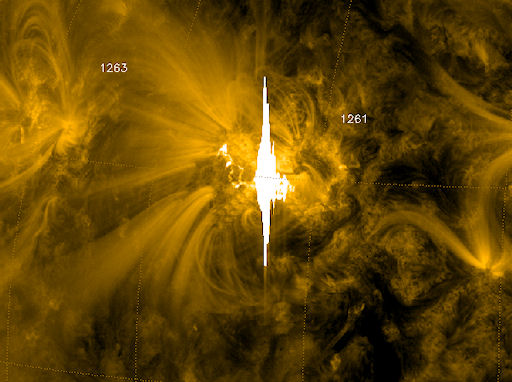
Kans van X-Flare van sunspot (30-07-2011)quote:Op vrijdag 29 juli 2011 11:50 schreef Frutsel het volgende:
[..]
Hmmm... een kansje op een X-class vlam die earth directed zou zijn? Afwachten
1260 = 57%
1261 = 41%
1283 = 4%
[BRON:[/b] http://yfrog.com/hsv7ywp
Maar het kan nog allemaal veranderen de komende tijd
http://www.lmsal.com/solarsoft/last_events/

Februari was toch de laatste en grootste zonnevlam sinds 4 jaar?
Rond 5 Augustus zou ie hier aankomen...
We zullen wel weer niks te zoen krijgen
Spaceweather.comquote:M6-CLASS SOLAR FLARE: Earth orbiting satellites have just detected a significant M6-class solar flare. The source appears to be sunspot 1261. Increased energetic proton fluxes are possible in the vicinity of Earth. Stay tuned for updates.
www.spaceweather.com
www.spaceweather.com
het gaat ineens wel los zeg

According to the model, Earth's magnetic field will receive a double-strike from the clouds on August 4th at 22:39 UT plus minus 7 hours. Mild to moderate geomagnetic storms are possible when the CMEs arrive.
Cleveland Volcano staat op springen... zou er een verband zijn?
Flinke beving op komst? Ik las ergens (en ik ben gvd de link kwijt) dat er ook veel zonneactiviteit was voor de zware aardbeving in Japan eerder dit jaar. Kan dit alleen niet verifiŽren.
Earth impact major? Wat moet ik me daar bij voorstellen? Iemand een idee?quote:Moving at an estimated speed of 1950 km/s, this CME is expected to sweep up two earlier CMEs already en route. Analysts at the GSFC Space Weather Lab say the combined cloud should reach Earth on August 5th at 13:55 UT plus or minus 7 hours: "The impact on Earth is likely to be major. The estimated maximum geomagnetic activity index level Kp is 7 (Kp ranges from 0 - 9). The flanks of the CME may also impact STEREO A, Mars and Mercury/MESSENGER." High-latitude sky watchers should be alert for auroras. Aurora alerts: text, voice.
[ Bericht 2% gewijzigd door #ANONIEM op 04-08-2011 17:05:15 ]
Frutsel, je hebt gelijk. Voorafgaand aan de ramp in Japan heeft er op 9 maart een CME plaatsgevonden(X1.5). Je kunt via de archives van spaceweather.com een willekeurige datum ingeven en dan krijg je de zonne-activiteit van die datum. Heel cool om dit te doen met alle natuurrampen, om eventuele verbanden te signaleren. Heeft er iemand data en tijd?quote:Op donderdag 4 augustus 2011 14:14 schreef Frutsel het volgende:
Zal me benieuwen... zonneactiviteit... en natuurrampen... geen leuke combinatie...wel voor speculatie... genoeg mensen die geloven in een verband..
Cleveland Volcano staat op springen... zou er een verband zijn?


Flinke beving op komst? Ik las ergens (en ik ben gvd de link kwijt) dat er ook veel zonneactiviteit was voor de zware aardbeving in Japan eerder dit jaar. Kan dit alleen niet verifiŽren.
En....de CME's van de afgelopen dagen hebben wellicht poollicht tot gevolg met een KP van boven de 7...spannend....I stay tuned...
quote:A coronal mass ejection (CME) is an ejection of material from the solar corona, observed with a white-light coronagraph.
The material consists of plasma consisting primarily of electrons and protons (in addition to small quantities of heavier elements such as helium, oxygen, and iron), plus the entrained coronal magnetic field. When the solar cloud reaches the Earth as an ICME (Interplanetary CME), it may disrupt the Earth's magnetosphere, compressing it on the dayside and extending the nightside tail. When the magnetosphere reconnects on the nightside, it creates trillions of watts of power which is directed back towards the Earth's upper atmosphere. This process can cause particularly strong aurora also known as the Northern Lights(in the Northern Hemisphere) and the Southern Lights(in the Southern Hemisphere). CME events, along with solar flares, can disrupt radio transmissions, cause power outages (blackouts), and cause damage to satellites and electrical transmission lines.
Bovenstaand dus een simpele uitlegging van de impact van een CME. Vooral het aardegericht zijn van zo'n CME en nu dus de combinatie van meerdere M- flares die op de aarde gericht waren, kunnen dus zorgen voor enige atmosferische onrust. Hoeveel onrust dat gaat worden is lastig te zeggen; afwachten dus....quote:Op donderdag 4 augustus 2011 17:04 schreef Scrummie het volgende:
Bron: Spaceweather.com
[..]
Earth impact major? Wat moet ik me daar bij voorstellen? Iemand een idee?
Er waren vanmorgen namelijk geen LW/MW zenders meer te ontvangen van _iets_ verder weg, alleen 1008KHz was vanmorgen nog iets om aan te horen...
quote:Op vrijdag 5 augustus 2011 21:47 schreef plankie het volgende:
Kan het zijn dat hierdoor de Middengolf vanmorgen al ernstig verstoord was?
Er waren vanmorgen namelijk geen LW/MW zenders meer te ontvangen van _iets_ verder weg, alleen 1008KHz was vanmorgen nog iets om aan te horen...
(bijbehorende afbeelding is te zien op spaceweather.com).quote:NIGHT-TIME SOLAR RADIO BURST: The M9-class solar flare of August 4th produced a burst of shortwave static so powerful that receivers on Earth picked it up after sunset. "A RadioJove observer in Florida recorded the burst when the sun was 38 degrees below the horizon," reports amateur radio astronomer Thomas Ashcraft. Ashcraft's own radio telescope in New Mexico recorded the event 1 hour and 54 minutes after sunset:
"To my knowledge, receptions like this are very rare," says Ashcraft.
http://www.fmtvdx.eu/tvdx/dx-hobby-1979.html(staat een technisch verhaal over korte- en middengolf en zonnevlekken)
Lees, kijk en oordeel zelf???
Ik wacht nog heel even af tot de zekerheid er is, dan met de camera naar de dijk!
Ik ben een half uur geleden met mijn vriendin ver buiten de stad gereden, helaas niets gezien...quote:Op vrijdag 5 augustus 2011 23:40 schreef zenkelly het volgende:
Ga naar buiten en kijk nu of je noorderlicht ziet!!! KP=8!!!!!!!! Er is nieuwe maan, dus geen verstoring. Ook de bewolking valt nog mee....wie o wie heeft wat gezien???

Bron:
http://www.spaceweather.c(...)53487_1312585741.jpg
Volgens de EXIF info is deze foto gemaakt op: August 5, 2011 10:59:41PM
Poollicht, ook wel noorderlicht of aurora borealis genoemd, is soms ook vanuit Nederland of BelgiŽ zichtbaar, gemiddeld enkele keren per jaar. Deze site biedt actuele informatie over de kans op noorderlicht in Nederland.
3 Komende dagen
6 aug: behoorlijke kans op noorderlicht
7 aug: kleine kans
8 aug: zeer kleine kans
http://www.poollicht.info/
Is die 6 augustus nu vandaag dus vanavond of is dat alweer 7 augustusquote:Op zaterdag 6 augustus 2011 14:55 schreef -CRASH- het volgende:
Noorderlicht in Nederland
Poollicht, ook wel noorderlicht of aurora borealis genoemd, is soms ook vanuit Nederland of BelgiŽ zichtbaar, gemiddeld enkele keren per jaar. Deze site biedt actuele informatie over de kans op noorderlicht in Nederland.
3 Komende dagen
6 aug: behoorlijke kans op noorderlicht
7 aug: kleine kans
8 aug: zeer kleine kans
http://www.poollicht.info/
Vanavond(6 aug. dus!) weer een kleine kans, mits het niet bewolkt is, dus......
Ik hoop dat de bewolking wegtrekt. Zoals het er nu uitziet gaan we er niets van zien.quote:Op zaterdag 6 augustus 2011 14:18 schreef Maver24 het volgende:
is er vanavond ook nog kans op poollicht in NL ???
Op spaceweather Staat een 24 uurse verwachting: KP7 strong...
En bij een KP7 zou er ook PL zichtbaar zijn vanuit NL.

KP9 zou ik toch liever zien
Vers van de pers, net gebeurd, dus verder nog geen info. Ik vermoed dat het zonnevlek 1263 is geweest, die net wegdraait van de aarde.Dus waarschijnlijk merken wij er op aarde weinig van, omdat het niet aardegericht was. Maar toch weer eens een X/flare! . Een X 6.9, dus...quote:Space Weather Message Code: SUMX01
Serial Number: 70
Issue Time: 2011 Aug 09 0812 UTC
SUMMARY: X-ray Event exceeded X1
Begin Time: 2011 Aug 09 0748 UTC
Maximum Time: 2011 Aug 09 0805 UTC
End Time: 2011 Aug 09 0808 UTC
X-ray Class: X6.9
Optical Class: 2b
Location: N17W69
NOAA Scale: R3 - Strong
Wat is de bron?
Het was idd 1263...wat mooi is dat: het staat ook al op youtube! Spaceweather slaapt nog.......
Misschien wacht Spaceweather op definitieve bevestiging ofzo
Nog een mooi filmpje:quote:Op dinsdag 9 augustus 2011 11:46 schreef zenkelly het volgende:
Het was idd 1263...wat mooi is dat: het staat ook al op youtube! Spaceweather slaapt nog........
http://sdowww.lmsal.com/s(...)1-193-171_N17W71.mov

[ Bericht 1% gewijzigd door basst2005 op 09-08-2011 12:58:50 ]

[ Bericht 50% gewijzigd door basst2005 op 09-08-2011 14:36:30 ]
Ik zie helaas nietsquote:Op dinsdag 9 augustus 2011 14:05 schreef basst2005 het volgende:
Wat betekend dit precies?
[ afbeelding ]
Heb hem even hier gezet, zo wel zichtbaar?:quote:
http://www.basst.nl/wp-content/uploads/2011/08/SEP_09_08.jpg
MAJOR SOLAR FLARE: This morning at 0805 UT, sunspot 1263 produced a powerful X7-class solar flare. NASA's Solar Dynamics Observatory captured the explosion's extreme ultraviolet flash:quote:Op dinsdag 9 augustus 2011 11:42 schreef Frutsel het volgende:
Een X 6.9??? WTF?? Mazzel dat die dan niet earth-directed was
Wat is de bron?
The brunt of the explosion was not Earth directed. Nevertheless, a minor proton storm is in progress around our planet, which could affect satellites in high-altitude orbits. Also, radiation from flare created waves of ionization in Earth's upper atmosphere, briefly disrupting communications at some VLF and HF radio frequencies.
SOHO coronagraphs show a CME emerging from the blast site. The cloud will probably miss Earth. At this time, however, we cannot rule out a glancing blow from the flank of the CME on or about August 11th. Stay tuned for updates
www.spaceweather.com
[ Bericht 81% gewijzigd door Frutsel op 16-08-2011 09:56:06 ]
Bron: Spaceweatherquote:EMERGING SUNSPOT: A big new sunspot is emerging over the sun's northeastern limb. AR1271 has at least four dark cores and it is crackling with small flares. The sunspot's entrance was captured in this 24-hour movie from the Solar Dynamics Observatory:
NOAA forecasters estimate a 60% chance of M-class solar flares during the next 24 hours. Because of its location near the sun's limb, AR1271 does not yet pose a threat for Earth-directed eruptions. This could change in the days ahead, however, as the sunspot turns to face our planet. Readers with solar telescopes are encouraged to monitor developments.
quote:Nasa briefing on Thursday due to recent Solar Flare activity
Solar Flare Activity Prompting NASA to Convene a News Briefing Thursday in Washington.
Increasing solar activity and the threat that coronal mass ejections (CME) pose to Earth has prompted NASA to convene a news briefing at its Headquarter building in Washington on Thursday afternoon.
Thursday’s briefing has been arranged, space agency officials say, in light of new information coming from NASA’s Solar Terrestrial Relations Observatory (STEREO), spacecraft and other NASA probes. The briefing will feature new details about the structure of solar storms and the impact they have on Earth.
The briefing panellists are Madhulika Guhathakurta, STEREO program scientist; Craig DeForest, staff scientist, Southwest Research Institute, David Webb, research physicist, Institute for Scientific Research, Boston College; and Alysha Reinard, research scientist, National Oceanic and Atmospheric Administration (NOAA) and the University of Colorado.
A massive solar flare, the largest recorded in four years, occurred last Tuesday prompting fears the blast could result in some disruption to Global Positioning Satellites (GPS) or communication signals around the world.
Solar flares happen when the powerful magnetic fields in and around the sun reconnect. They’re usually associated with active regions, often seen as sun spots, where the magnetic fields are strongest. The most powerful flare on record was in 2003, during the last solar maximum. It was so powerful that it overloaded the sensors measuring it. The current solar cycle will peak in 2013.
A powerful X-class flare can create long lasting radiation storms, which can harm satellites and even give airline passengers, flying near the poles, small radiation doses. X flares also have the potential to create global transmission problems and world-wide blackouts.
In 1989, a geomagnetic storm energised ground induced currents which disrupted electric power distribution throughout most of Quebec province in Canada and produced aurora borealis displays as far south as Texas in the USA.
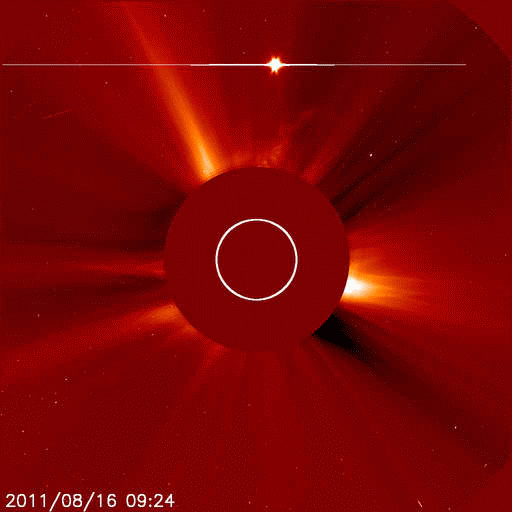
http://www.space.com/1264(...)iefing-thursday.html
Als Venus de Aarde was, waren wij er niet meer..quote:Op woensdag 17 augustus 2011 17:42 schreef -CRASH- het volgende:
VENUS AND THE SOLAR STORM:[ afbeelding ]
Dat is een 2D clipje.quote:Op woensdag 17 augustus 2011 22:29 schreef Scrummie het volgende:
[..]
Als Venus de Aarde was, waren wij er niet meer..
De werkelijk afstand van Venus/Zon is veel groter. Dus of op de voorgrond of in de achtergrond.
Bron: http://www.nu.nl/wetensch(...)en-voorspelbaar.htmlquote:Ontstaan zonnevlekken is voorspelbaar
AMSTERDAM - Wetenschappers van Stanford University hebben een manier bedacht om zonnevlekken-in-wording te detecteren, terwijl deze zich nog 65.000 kilometer onder het zonsoppervlak bevinden.
Dat meldt het wetenschappelijke tijdschrift Science op donderdag.
Dat maakt het mogelijk om actieve gebieden op de zon, die ook de bron zijn van grote uitbarstingen, een paar dagen van te voren te zien aankomen.
Akoestische golven
De nieuwe methode maakt gebruik van de akoestische golven in het inwendige van de zon, die worden veroorzaakt door turbulenties in het hete zonnegas. Deze golven gaan naar het kerngebied van de zon en worden weer teruggekaatst naar het oppervlak.
Hierdoor ontstaat een regelmatig patroon van op en neer gaande gebieden op de zon, dat waarneembaar is met satellieten als SOHO en SDO. Het analyseren van de akoestische golven die door de zon gaan, is vergelijkbaar met seismisch onderzoek op de aarde.
Magnetische velden
Door de aankomsttijden van de golven op vele verschillende punten op de zon te meten, kan worden vastgesteld of zij onderweg zijn opgehouden door sterke magnetische velden. Zo'n sterk magnetisch veld is een aanwijzing dat er een zonnevlek op komst is.
De wetenschappers hebben vastgesteld dat je zo niet alleen het ontstaan van nieuwe zonnevlekken kunt zien aankomen, maar ook kunt voorspellen hoe omvangrijk deze worden. Grote zonnevlekken-in-wording stijgen twee keer zo snel naar de oppervlakte als kleine.
http://hmi.stanford.edu/Press/18Aug2011/
Waarom willen vrouwen/mannen weten of ze een jongen of een meisje gemaakt hebben als die nog in de buik zit? Je kan het toch niet veranderen en toch doen we het.quote:Op zaterdag 20 augustus 2011 00:14 schreef Lumberbob het volgende:
Wat heb je er aan te weten of er zonnevlammen jouw kant op komen, aangezien het de atmosfeer aantast. Kun je geen donder aan doen, of je 't nou wel of niet weet.
quote:M5.3 Solar Flare:
A moderate sized Solar Flare took place at 01:50 UTC Tuesday morning. An R2 Level radio blackout resulted. The solar flare was centered around Sunspot 1283 which is located in the center of the visible solar disk. While looking at the latest STEREO Ahead COR2 images, there appears to be a CME. More images will be needed to determine just how big
quote:EARTH-DIRECTED FLARE: This morning at 0150 UT, sunspot 1283 produced an M5.3-class solar flare. A movie from NASA's Solar Dynamics Observatory shows the flash of extreme UV radiation. Because of the sunspot's central location on the solar disk, the eruption was Earth-directed and a CME might be heading our way. Stay tuned for updates.
quote:

Filmpje:
http://sdowww.lmsal.com/s(...)1-193-171_N13W18.mov
quote:STRONG SOLAR ACTIVITY: Sunspot 1283 is crackling with solar flares. Yesterday, Sept. 6th, the active region produced an M5.3-class eruption at 0150 UT followed by a X2.1-class event at 2220 UT. NASA's Solar Dynamics Observatory recorded this extreme UV flash from the X-flare:
The flares produced waves of ionization in Earth's upper atmosphere, briefly altering the propagation of low-frequency radio signals around our planet. Moreover, the two eruptions hurled clouds of plasma (CMEs) in our general direction. A preliminary analysis of SOHO and STEREO imagery suggests that the CMEs could sail substantially north of Earth, delivering a glancing blow to Earth's magnetic field as they pass. ETA: Sept. 8-10. Stay tuned for updates
quote:NOTHER X-FLARE: Earth-orbiting satellites have detected another strong flare from sunspot 1283. The X1.8-class event at 2238 UT on Sept. 7th produced a bright flash of extreme UV radiation and hurled an inky-dark plume of plasma into space. Click to view the movie from NASA's Solar Dynamics Observatory:
This is the third significant flare from sunspot 1283 since Sept. 6th. All three eruptions propelled CMEs in the general direction of Earth. Not one of the CMEs, however, will hit our planet squarely. Glancing blows from the three clouds will commence sometime on Sept. 9th and continue through Sept. 11th, possibly sparking minor geomagnetic storms.
http://www.poollicht.info/
Kan zijn als er wat te zien is dat het druk wordt op
http://chat.poollicht.nl/
Maar half NL zit onder de bewolking...
op http://www.poollicht.info/ slaat de monitor geel uit tot
de 59 graden lijn
en hier in limburg is het half bewoikt en soms een tijd helder
maar de lucht is niet schoon. Te veel vocht in de lucht
http://www.lmsal.com/solarsoft/last_events/gev_20110922_1029.html
Filmpje:
http://sdowww.lmsal.com/s(...)1-193-171_N09E89.mov
[ Bericht 33% gewijzigd door basst2005 op 22-09-2011 14:41:26 ]
The Sun has just produced an X1.4 flare. It originated in a new active region on the eastern limb. There is little chance of any earth-directed effects, but this might change over the next few days if as the region rotates into line with the earth.quote:
Als we geen neerstortende satellietbrokken op ons dak krijgen is het wellicht een X-flare
Bron: http://www.spaceweather.com
Wanneer zal hij aarde-gericht zijn dan?
en, Frutsel, denk een dag of 2? Maar van de afgelopen flares komen er ook wel een paar langswaaien. Heb t idee dat er nog wel een X-flare of wat aan zit te komen....nu is de zon echt wakker!!quote:Inderdaad. Nog een M7.1 flare uit dezelfde hoek
Wanneer zal hij aarde-gericht zijn dan?
Toen kwam er ff een enorme zonnevlek voorbij.
27ste, Redelijke kans
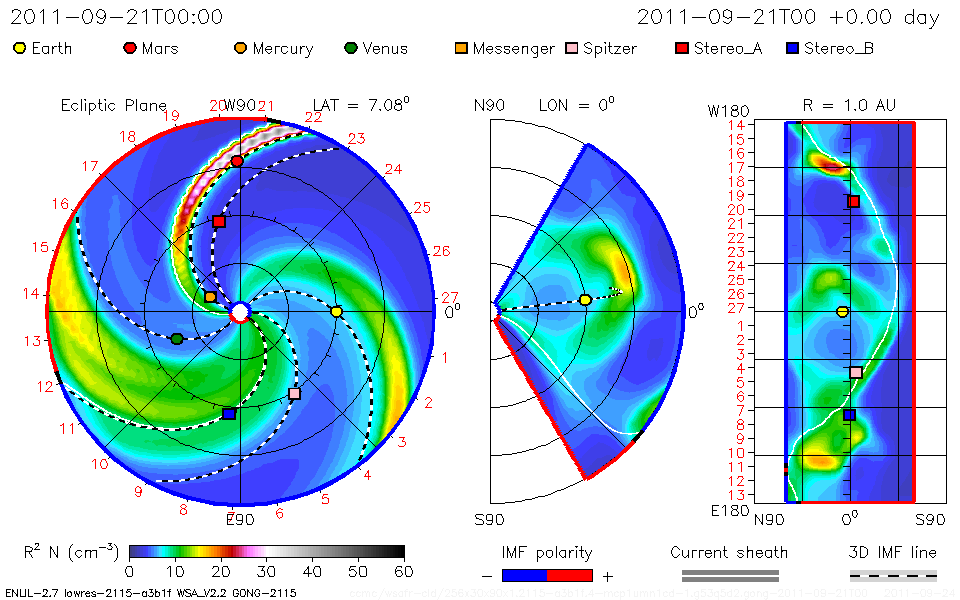
[ Bericht 4% gewijzigd door -CRASH- op 25-09-2011 15:44:33 ]
quote:Mega quakes occur more frequently when sun has fewer sunspots: researchers
The frequency of mega earthquakes increases during periods when the sun has fewer sunspots, a team of Japanese researchers has found.
The finding was made by a team led by Kiyofumi Yumoto, a researcher in space and earth electromagnetism at Kyushu University's Space Environment Research Center.
The March 11 Great East Japan Earthquake occurred when there were few sunspots. The latest research suggests that the sun's activity could influence movements beneath the earth's surface.
Sunspots gradually increase and decrease in number in a cycle of about 11 years, and cause changes in the earth's atmosphere. The research team investigated the possibility that they could also produce changes beneath the earth's surface, and compared data on the number of sunspots between 1963 and 2000 and the 327,625 earthquakes of magnitude 4 or more that occurred during this period.
The study found that 65 percent of the earthquakes with magnitudes between 4.0 and 4.9 occurred during the periods with the fewest sunspots (each lasting about two years). The figure was around the same for earthquakes with magnitudes between 5.0 and 7.9. However, the figure was higher for the 28 mega earthquakes with magnitudes in the 8.0-9.9 range, with 79 percent of them occurring during periods with the fewest sunspots.
When there are fewer sunspots, a phenomenon occurs in which solar winds, or streams of charged particles from the sun, get stronger an average of three to four times a month. Seventy percent of the earthquakes of magnitude 6.0 or stronger occurred at such times.
Solar winds that become stormy are known to be able to induce strong currents in power transmission lines, which can lead to major blackouts.
"The relationship between the sun and the activity of earthquakes is not clear, but we hope that this is a step in uncovering the mystery of quakes," Yumoto said.
The results of the group's research will be announced at a meeting of the Society of Geomagnitism and Earth, Planetary and Space Sciences, which opens in Kobe on Nov. 3.

Bron: Spaceweather.com
En dat was nog nieteens recht op de Aarde gericht. Misschien dat "schampschoten" wel meer impact hebben dan directe?quote:Op maandag 26 september 2011 21:58 schreef zenkelly het volgende:
CME(ťťn van de ..) is aangekomen: KP=8!!! Zelfs in BelgiŽ is nu poollicht te zien....wie kan de bewolking en regen ff wegduwen, dan zouden we hier ook wat kunnen zien!
Komen we misschien nog achter als zonnevlek 1302 nog een keertje blaast deze week.

http://spaceweather.com/s(...)aara__1317067529.jpg
Ik las iets over de sterkste geomagnetische storm sinds december 2006 ofzo.quote:Op maandag 26 september 2011 21:58 schreef zenkelly het volgende:
CME(ťťn van de ..) is aangekomen: KP=8!!! Zelfs in BelgiŽ is nu poollicht te zien....wie kan de bewolking en regen ff wegduwen, dan zouden we hier ook wat kunnen zien!
Zal me benieuwen of er nu ook een zeer zware aardbeving zal volgen binnen een paar dagen
Geen idee precies waarom want het was geen X-flare dacht ik?
Het is voor mij beginnende en boeiende materie
quote:Sunspot 1302
it's BIG...
it's BAD...
and it's coming our way...
Dat kan ik nergens lezen op spaceweather.com... maar we kijken nu wel bijna recht in de loop van het geweer.quote:
Btw... deze astroÔde staat ook maar pas in het lijstje:
2011 SE58 Sep 27 0.6 LD -- 13 m
quote:Op dinsdag 27 september 2011 20:00 schreef DemonRage het volgende:
[..]
Dat kan ik nergens lezen op spaceweather.com... maar we kijken nu wel bijna recht in de loop van het geweer.
twitter:spaceweather twitterde op dinsdag 27-09-2011 om 19:01:23Sunspot 1302: It's Big. It's Bad. And It's Coming Our Way http://srs.gs/16hN reageer retweet
Zag hem ook... maar tis maar een kleintje... die eind van het jaar komt dat is er zeker eentje die het nieuws gaat halenquote:Op dinsdag 27 september 2011 20:00 schreef DemonRage het volgende:
Btw... deze astroÔde staat ook maar pas in het lijstje:
2011 SE58 Sep 27 0.6 LD -- 13 m
Die van 8 november toch? Zo'n rotsblok van 175 meter doorsnede moeten we toch wel kunnen zien als die voor de zon langs gaat (weliswaar door een filter).quote:Op dinsdag 27 september 2011 20:08 schreef Frutsel het volgende:
[..]
Zag hem ook... maar tis maar een kleintje... die eind van het jaar komt dat is er zeker eentje die het nieuws gaat halen
Het was officiŽel de M7 flare die aankwam, maar had ook ergens gelezen(weet niet meer waar) dat het een combi was van de meerdere uitbarstingen, die elkaar versterkt hebben. De ťťn haalde de ander in enzovoort...wie t weet, mag t zeggen.quote:[Schijnbaar was de straling van deze solarflare ook bijzonder heftig.
Geen idee precies waarom want het was geen X-flare dacht ik?
Foto van de zonsondergang vanuit BelgiŽ (Spaceweather):
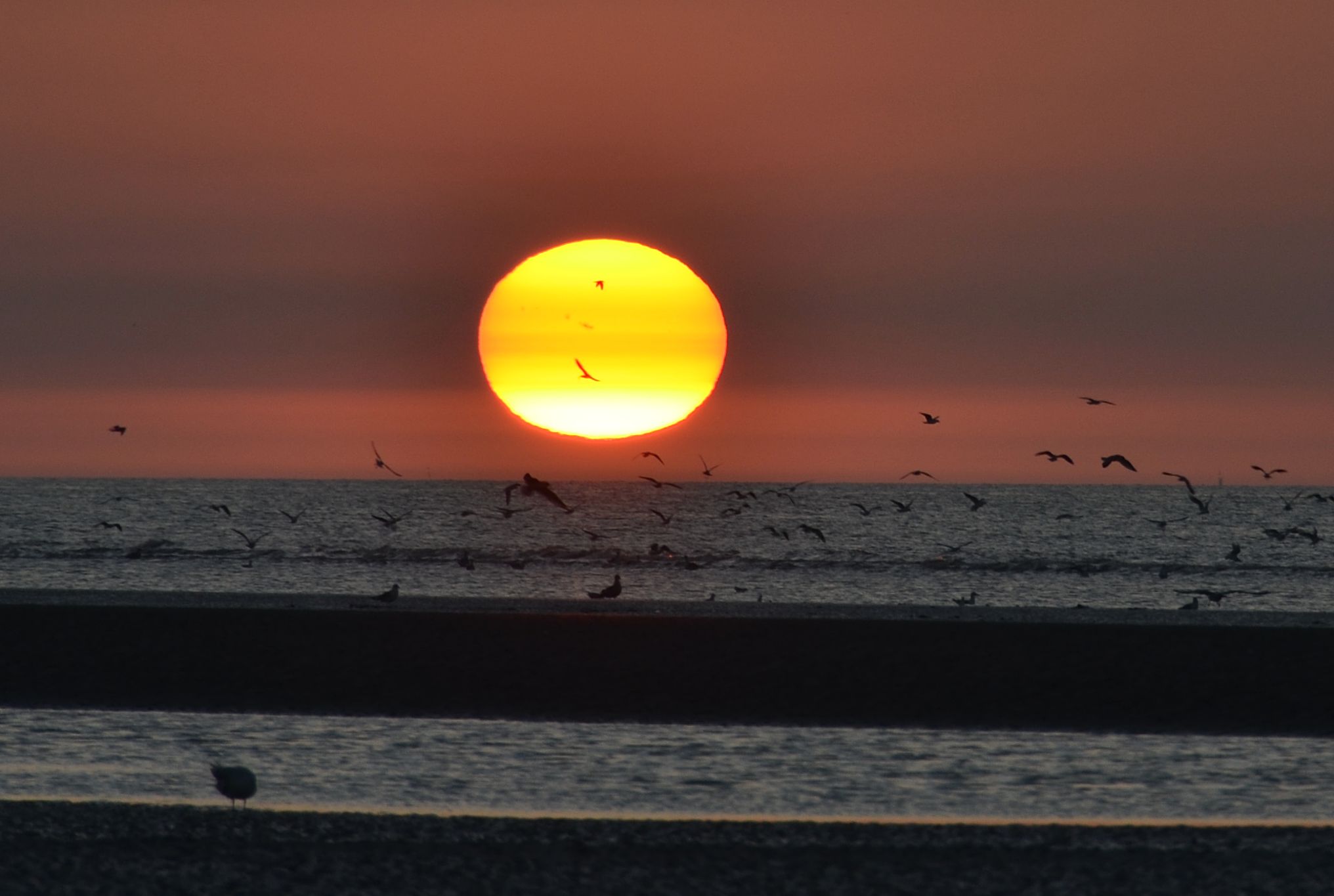

Waaaaauw, kan me haast niet voorstellen dat dit echt is!quote:Op woensdag 28 september 2011 20:58 schreef Roel_Jewel het volgende:
Noorderlicht vanuit het ISS:
[ afbeelding ]




Bron Spaceweather
Uit eigen keuken...quote:Op woensdag 28 september 2011 20:25 schreef DemonRage het volgende:
Vlekje 1302 staat nu recht op ons gericht... als die nou gaat blazen dan wordt het spannend.
Foto van de zonsondergang vanuit BelgiŽ (Spaceweather):
[ afbeelding ]

Gecropt

Whow prachtig!!! Wat voor lens heb je dat gemaakt?quote:Op woensdag 28 september 2011 21:11 schreef -CRASH- het volgende:
[..]
Uit eigen keuken...
[ link | afbeelding ]
Gecropt
[ link | afbeelding ]
+- 676mm lensquote:Op woensdag 28 september 2011 21:56 schreef meteo-online het volgende:
[..]
Whow prachtig!!! Wat voor lens heb je dat gemaakt?
Olympus SP 590 UZ
[ Bericht 13% gewijzigd door -CRASH- op 29-09-2011 00:16:09 ]
Aim, fire.quote:Op woensdag 28 september 2011 20:25 schreef DemonRage het volgende:
Vlekje 1302 staat nu recht op ons gericht... als die nou gaat blazen dan wordt het spannend.
Foto van de zonsondergang vanuit BelgiŽ (Spaceweather):
[ afbeelding ]


En twee beelden van net, grote vlammen veroorzaakt door de komeet (??)


De frames tussen 15:00 en 21:00 missen helaas, dus ik kan (nog) niet zien hoe ver de komeet is gekomen.
Spaceweather.com
Het valt me trouwens op dat er nog geen klasseringen zijn voor deze zonnevlammen.
[ Bericht 23% gewijzigd door DemonRage op 02-10-2011 12:58:36 ]
Op Speceweather nog niet, idd...Solarham wel:quote:Het valt me trouwens op dat er nog geen klasseringen zijn voor deze zonnevlammen.
Ben benieuwd naar de impact.....quote:M3.9 Flare: Sunspot 1305 continues to grow and at 00:50 UTC Sunday morning, an M3.9 Solar Flare took place. A Coronal Mass Ejection (CME) resulted, however the blast from the earlier M1.2 Solar Flare appears to be more geoeffective.
Long Duration M-Flare + CME: A long duration M1.2 Solar Flare took place around Sunspot 1305 at 09:59 UTC Saturday morning and a Earth Directed CME is on its way. The cloud of plasma is slow moving at 500 km/s.
Dus we krijgen een dubbele CME om onze oren... da's idd spannend.quote:Op zondag 2 oktober 2011 13:03 schreef zenkelly het volgende:
[..]
Op Speceweather nog niet, idd...Solarham wel:
[..]
Ben benieuwd naar de impact.....
Zoiets.....quote:Op zondag 2 oktober 2011 12:50 schreef DemonRage het volgende:
De uitbarstingen waren van zonnevlekken 1302 (die hele grote) en 1305 (ook niet echt een kleintje en recht op de aarde gericht). 1305 heeft een CME afgeschoten die ons op 4 oktober bereikt.
Spaceweather.com
Het valt me trouwens op dat er nog geen klasseringen zijn voor deze zonnevlammen.
Classification
The Sun shows a C3-class solar flare (white area on upper left), a solar tsunami (wave-like structure, upper right) and multiple filaments of magnetism lifting off the stellar surface.
Solar flares are classified as A, B, C, M or X according to the peak flux (in watts per square meter, W/m2) of 100 to 800 picometer X-rays near Earth, as measured on the GOES spacecraft. Each class has a peak flux ten times greater than the preceding one, with X class flares having a peak flux of order 10−4 W/m2. Within a class there is a linear scale from 1 to 9, so an X2 flare is twice as powerful as an X1 flare, and is four times more powerful than an M5 flare. The more powerful M and X class flares are often associated with a variety of effects on the near-Earth space environment. This extended logarithmic classification is necessary because the total energies of flares range over many orders of magnitude, following a uniform distribution with flare frequency roughly proportional to the inverse of the total energy. Stellar flares and earthquakes show similar power-law distributions.[5]
Another flare classification is based on Hα spectral observations. The scheme uses both the intensity and emitting surface. The classification in intensity is qualitative, referring the flares as: (f)aint, (n)ormal or (b)rilliant. The emitting surface is measured in terms of millionths of the hemisphere and is described below (The total hemisphere area AH=6.2 1012 km2.)
Classification ........ Corrected Area [millionths of hemisphere]
S.............................< 100
1.................................100 - 250
2.................................250 - 600
3.................................600 - 1200
4..............................> 1200
A flare then is classified taking S or a number that represents its size and a letter that represents its peak intensity, v.g.: Sn is a normal subflare
Classificatie Zonnevlammen
Wetenschappers classificeren zonnevlammen volgens de helderheid in de rŲntgenstraling.
Er zijn drie categorieŽn:
de X-klasse is zeer groot,
het zijn enorme gebeurtenissen die de oorzaak kunnen zijn van radio storingen over de hele Aarde en veroorzaken langdurige stralingsstormen in de bovenste lagen van de atmosfeer.
de M-klasse vlammen zijn middelmaat van grootte;
zij veroorzaken korte radiostoringen voornamelijk op hoge noorder en zuider breedtegraden. Geringe stralingsstormen volgen soms na een M-klasse vlam.
Vergeleken met X en M klasse gebeurtenissen
zijn C klasse vlammen klein en nauwelijks merkbaar op Aarde
GIF filmpjes van de inslag en CME(s):quote:Op zondag 2 oktober 2011 00:10 schreef basst2005 het volgende:
Er was gisteren (1 oktober) een komeet onderweg naar de zon, zie beelden van SOHO LASCO C2 en C3:
[ afbeelding ]
[ afbeelding ]
En twee beelden van net, grote vlammen veroorzaakt door de komeet (??)
[ afbeelding ]
[ afbeelding ]
De frames tussen 15:00 en 21:00 missen helaas, dus ik kan (nog) niet zien hoe ver de komeet is gekomen.
http://www.basst.nl/wp-co(...)Komeet_in_Zon_c2.gif
http://www.basst.nl/wp-co(...)Komeet_in_Zon_c3.gif
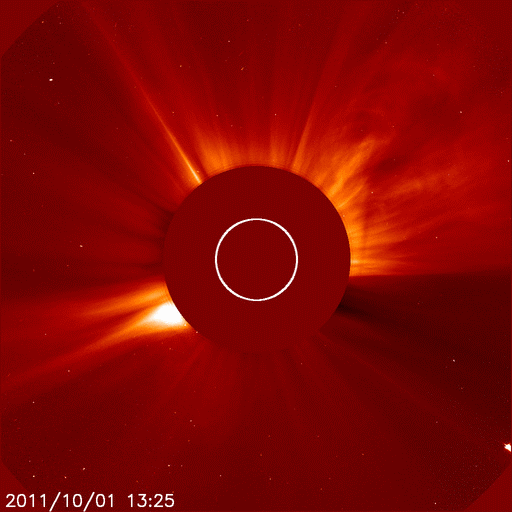
COMET AND CME: A comet discovered by amateur astronomers on Friday, Sept. 30th, disintegrated in spectacular fashion the very next day when it plunged into the sun. The Solar and Heliospheric Observatory recorded the comet's last hours. The end was punctuated by an unexpected explosion:
The timing of the CME so soon after the comet dove into the sun suggests a link. But what? There is no known mechanism for comets to trigger solar explosions. Before 2011 most solar physicists would have discounted the events of Oct. 1st as pure coincidence--and pure coincidence is still the most likely explanation. Earlier this year, however, the Solar Dynamics Observatory (SDO) watched another sungrazer disintegrate in the sun's atmosphere. On July 5, 2011, the unnamed comet appeared to interact with plasma and magnetic fields in its surroundings as it fell apart. Could a puny comet cause a magnetic instability that might propagate and blossom into a impressive CME? The question is not so crazy as it once seemed to be.
De bron is een bericht uit februari hoorquote:Op dinsdag 11 oktober 2011 16:49 schreef Maron het volgende:
http://www.earth-matters.(...)reem-ruimteweer.html
Misschien valt 't daarom ook onder 'grenswetenschap'quote:Op dinsdag 11 oktober 2011 16:55 schreef Frutsel het volgende:
[..]
De bron is een bericht uit februari hoor
bron:solarham.comquote:Op zaterdag 22 oktober 2011 15:02 schreef zenkelly het volgende:
While looking at the latest STEREO Ahead images, there appears to be a very bright and possibly a partially earth directed Coronal Mass Ejection blasting away from the Sun during the early hours on Saturday. The source of this explosion may have been a Solar Filament burst. Please watch the video below.
Er gaat namelijk een CME die richting op

SPACE WEATHER FORECAST FOR MARS:
Dan zal het vast een man zijnquote:Is er iemand die rond de 26ste toevallig op vakantie is op Mars
Rode band te zien van het westen tot helemaal naar het oosten, te zien door de gaten in de wolken
Het wordt nu minder helder, alleen nog een beetje een paarse gloed 1.00
Het is nu echt weg



[ Bericht 6% gewijzigd door blids op 25-10-2011 07:01:28 ]
Van rond middernacht... en ik was nog wakker ook. http://www.adressa.no/nyheter/trondheim/article1716182.ece

Spaceweather.comquote:SOLAR ACTIVITY IN THE OFFING: A big sunspot is emerging over the sun's NE limb. Yesterday it unleashed an M1-class solar flare (SDO movie) and hurled a coronal mass ejection into space. Geoeffective solar activity could increase in the days ahead as the sun's rotation turns the sunspot toward Earth.
Opgelet! Noorderlicht is nu in heel ScandinaviŽ te zien, het wordt daar al donker Kp 5

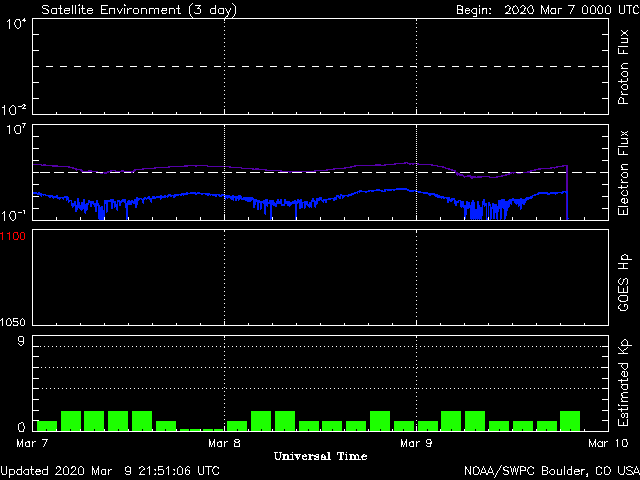
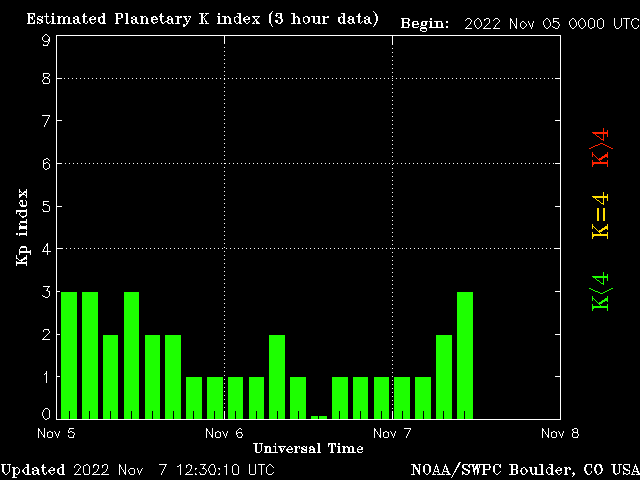
Hm...40.000km groot... das 2x heen en terug naar Tokyo ofzoquote:BIG SUNSPOT: A large sunspot group is rotating over the sun's northeastern limb, possibly signaling an uptick in solar activity. NASA's Solar Dynamics Observatory took this picture during the early hours of Nov. 2nd:
Measuring some 40,000 km wide and at least twice that in length, the behemoth active region is an easy target for backyard solar telescopes. Astronomers are encouraged to monitor the region: NOAA forecasters estimate a 60% chance of M-class solar flares during the next 24 hours. Eruptions today would not be Earth directed, but future eruptions could be as the sunspot turns toward our planet in the days ahead.
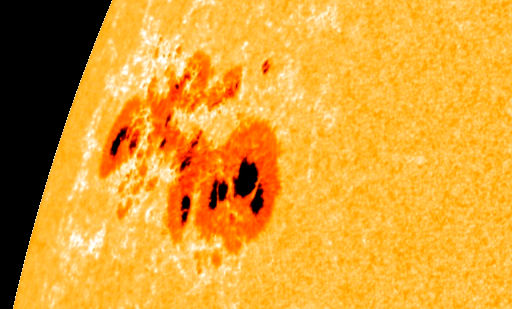
quote:One of the largest sunspots in years is rotating over the sun's northeastern limb. NASA's Solar Dynamics Observatory took this picture of AR1339 during the early hours of Nov. 3rd:
Measuring some 40,000 km wide and at least twice that in length, the sprawling sunspot group is an easy target for backyard solar telescopes. Two or three of the sunspot's dark cores are wider than Earth itself.
Naturally, such a large sunspot has potential for strong flares. NOAA forecasters estimate a 50% chance of M-class solar flares during the next 24 hours. One such eruption has already occured: An M4-flare at 2200 UT on Nov. 2nd produced a bright flash of extreme UV radiation (SDO movie) and hurled a coronal mass ejection (CME) into space. The CME is not heading our way. Future CMEs could have greater effect as AR1339 turns toward Earth in the days ahead

[ Bericht 53% gewijzigd door blids op 03-11-2011 23:27:11 ]
Vandaag een M2.59 en een X1.99
Het gaat weer de goede kant uit
The sunspot has already unleashed one X-flare on Nov. 3rd around 2027 UT. A movie from NASA's Solar Dynamics Observatory shows the extreme ultraviolet flash:
Bekijk filmpje op www.spaceweather.com
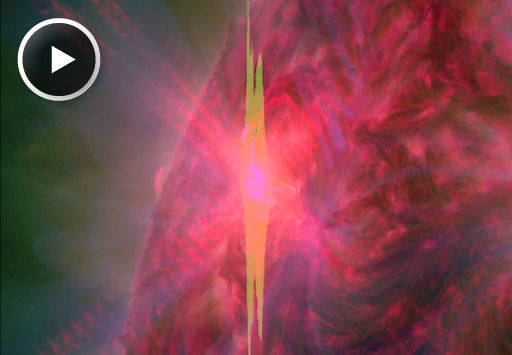
The flare created waves of ionization in Earth's upper atmosphere, altering the normal propagation of radio waves over Europe and the Americas. In Ireland, the flare's effect was felt even after dark.
A cloud of plasma or "CME" raced away from the blast site at 1100 km/s. The CME is not heading for Earth. It is, however, heading for Mercury and Venus. Click on the arrow to view a movie of the CME's forecast track:
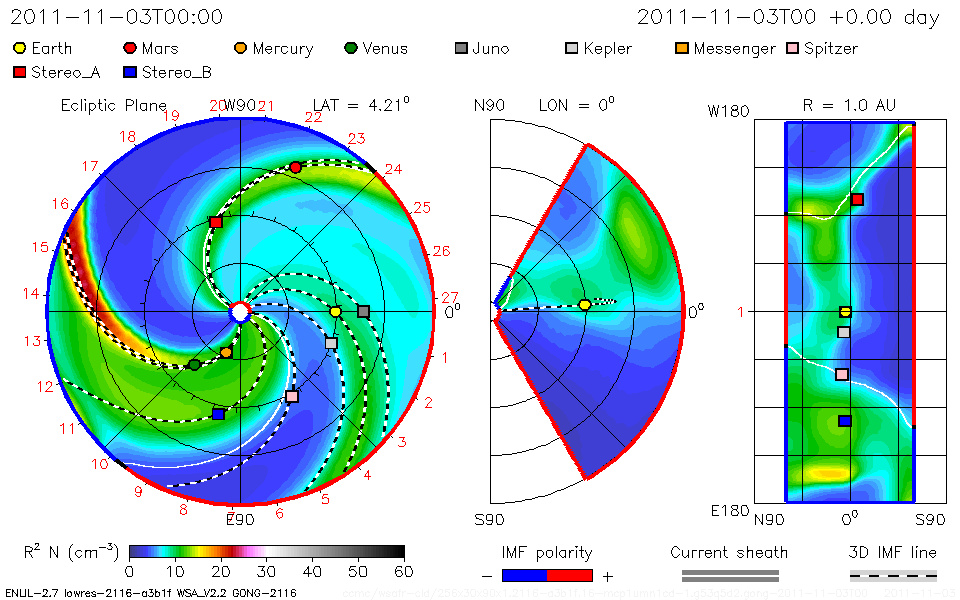
[ Bericht 4% gewijzigd door -CRASH- op 04-11-2011 18:28:11 ]
quote:5 M-class solar flares in 24 hours
November 6, 2011 – Sunspot AR1339 is crackling with M-class solar flares, unleashing at least five of them in the past 24 hours. The blasts have been coming with such thick frequency that photographer Randy Shivak of Elyria, Ohio, was able to catch one in action on Nov. 5th: “Looking like iron filings around a bar magnet, sunspot group 1339 showed itself in the throes of a solar flare,” says Shivak. Even bigger eruptions are possible before the weekend is over. AR1339 has a delta-class magnetic field that harbors energy for X-class flares. The sunspot is turning toward Earth, so the odds of a geo-effective flare are increasing. Sunspot 1339 has a delta-class magnetic field that harbors energy for X-class solar flares.
Big sunspot 1339 has quieted since a flurry of M-flares on Saturday,
but the active region still poses a threat for strong eruptions.
NOAA forecasters estimate a 70% chance of M-flares and a
10% chance of X-flares during the next 24 hours
www.spaceweather.com
volledige halo CME, is op weg naar de Aarde. De aankomst is voorzien in de
nacht van 11 op 12 november en kan een kleine kans op poollicht veroorzaken
voor de Lage Landen.
Meer info over de poollichtkans op ons forum:
http://www.spaceweatherlive.com/community/index.php?topic=3149.0
quote:REMARKABLE SOLAR ACTIVITY: There haven't been any strong solar flares in days. Nevertheless, some impressive activity is underway on the sun. For one thing, an enormous wall of plasma is towering over the sun's southeastern horizon. Stephen Ramsden of Atlanta, Georgia, took this picture on Nov. 11th:
"Solar forums all over the world are buzzing with Sun-stronomers proclaiming this to be the biggest prominence that many of them had ever witnessed," he says.
Remarkably, though, this is not the biggest thing. A dark filament of magnetism is snaking more than halfway around the entire sun: SDO image. From end to end, it stretches more than a million km or about three times the distance between Earth and the Moon. If the filament becomes unstable, as solar filaments are prone to do, it could collapse and hit the stellar surface below, triggering a Hyder flare. No one can say if the eruption of such a sprawling structure would be Earth directed.
Bron: www.spaceweather.com
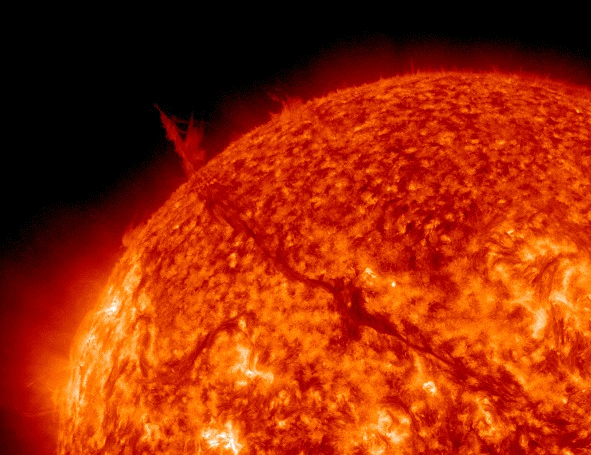
For the past few days, astronomers around the world have been monitoring a dark filament of magnetism sprawled more than 1,000,000 kilometers across the face of the sun. Make that 750,000 km. On Nov. 14th the filament snapped and flung a fraction of itself into space.
The eruption hurled a cloud of plasma into space, but not toward Earth. The only effect on our planet would be to disappoint observers hoping for a longer filament.
http://www.spaceweather.com
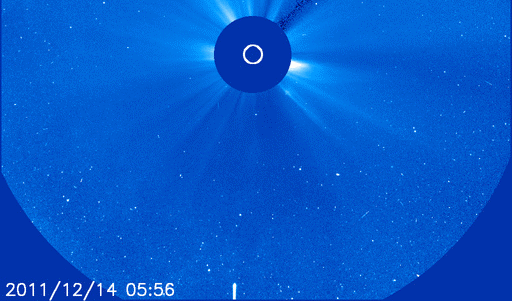
Bron: Spaceweatherquote:Comet Lovejoy (C/2011 W3) is diving into the Sun and furiously vaporizing as it approaches the stellar surface. The Solar and Heliospheric Observatory (SOHO) is recording the kamikaze plunge. “This is, without any doubt, the brightest sungrazing comet that SOHO has ever seen,” says comet researcher Karl Battams of the Naval Research Lab in Washington DC. The comet’s nucleus, thought to be twice as wide as a football field, will skim approximately 140,000 km (1.2 solar radii) above the solar surface on Dec. 15/16. At such close range, solar heating will almost certainly destroy the comet’s icy core, creating a cloud of vapor and comet dust that will reflect lots of sunlight. “If Comet Lovejoy gets as bright as magnitude -4 or -5, there is a tiny but non-zero chance that it could become visible in the sky next to the Sun,” says Battams. Indeed, something similar happened to Comet McNaught in January 2007 when it was visible in broad daylight: gallery. Standing in the shadow of a tall building to block the sun allowed the comet to be seen in blue sky nearby. “Comet Lovejoy will be reaching perihelion (closest approach to the sun) right around sunset on Dec. 15th for people in the US East, Central, Mountain, and Pacific time zones,” continues Battams. “Be alert for the comet to the left of the sun at that time.” Caution: Do not look at or near the sun through unfiltered optics; focused sunlight can seriously damage your eyes. Discovered on Dec. 2nd by amateur astronomer Terry Lovejoy of Australia, the comet is an unusually large member of the Kreutz family. Kreutz sungrazers are fragments of a single giant comet (probably the Great Comet of 1106) that broke apart back in the 12th century. SOHO sees one plunging into the Sun every few days, but most are small, no more than 10 meters wide. Comet Lovejoy is at least ten times larger than usual
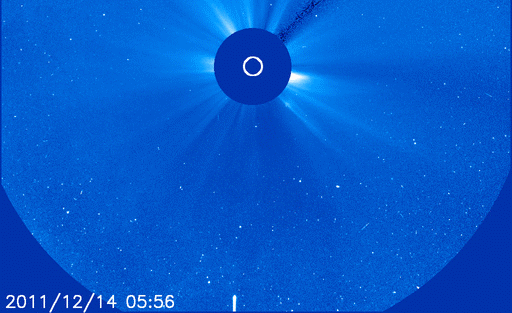
De komeet was overdag zichtbaar.....
"Comet Lovejoy will be reaching perihelion (closest approach to the sun) right around sunset on Dec. 15th for people in the US East, Central, Mountain, and Pacific time zones," continues Battams. "Be alert for the comet to the left of the sun at that time." Caution: Do not look at or near the sun through unfiltered optics; focused sunlight can seriously damage your eyes.
Incredibly, sungrazing Comet Lovejoy has survived its close encounter with the sun. Lovejoy flew only 140,000 km over the stellar surface during the early hours of Dec. 16th. Experts expected the icy sundiver to be destroyed. Instead, NASA's Solar Dynamics Observatory caught the comet emerging from perihelion (closest approach) apparently intact:

[ Bericht 22% gewijzigd door -CRASH- op 17-12-2011 00:11:18 ]
Dat meldt de gespecialiseerde website spaceweather.com.
Volgens de website denken specialisten van de Amerikaanse weerdienst NOAA dat er woensdag 30 tot 40 procent kans is op een geomagnetische storm, wanneer de CME en inkomende stroom zonnewind (die niet met die plasmawolk gerelateerd is) snel na elkaar kunnen aankomen. In de nacht van woensdag op donderdag is er in hogere breedtegraden mogelijk poollicht te zien. Vanaf welke breedtegraad er echt kans is, is onduidelijk.
bron: volkskrant
De tweede (zwakke) CMR komt vanavond/vannacht en de kans dat we
hier iets zien is gering tot niks
KP5

Emerging over the sun's southeastern limb, sunspot AR1389 unleashed an M2-class solar flare at 1350 UT on Dec. 29th. The blast shows that the newly-visible sunspot is capable of significant eruptions. AR1389 is not yet facing Earth, but it is turning in our direction.
A magnetic active region behind the sun's eastern limb erupted during the late hours of Jan. 6th.
SOHO recorded the flying debris. In a few days the blast site will rotate onto the
Earthside of the sun for closer inspection. Stay tuned.

Gaan wij daar nog iets van meekrijgen? Zo ja, hoe?quote:In a few days the blast site will rotate onto the Earthside of the sun for closer inspection.
Van deze CME niet(s)quote:Op zaterdag 7 januari 2012 22:26 schreef Nemephis het volgende:
[..]
Gaan wij daar nog iets van meekrijgen? Zo ja, hoe?
Maar dan kunnen ze waarschijnlijk de oorzaak ervan achterhalen
Ah duidelijk. senk joequote:Op zaterdag 7 januari 2012 22:33 schreef -CRASH- het volgende:
[..]
Van deze CME niet(s)
Maar dan kunnen ze waarschijnlijk de oorzaak ervan achterhalen
Zonnevlammen #3: As The Sun Turns


 Op
Op  Op
Op 

 Op
Op 
















